Brightin Star 28mm F2.8 Micro-Pancake Review
Dustin Abbott
December 18th, 2023

The subject of today’s review is so unique that I had to make up a new name for it. I called it a “micro-pancake” lens, as it is so small that it makes ordinary pancake lenses seem large. The Brightin Star 28mm F2.8 is a really unique lens that certain photographers will probably fall in love with. In other ways it is completely impractical. This is a lens that is only 9.9mm long and is finished in a beautiful black lacquer coating, making it more of an art piece for those who love photography than perhaps a working lens…though it is in many ways a capable lens. Is this little piece of art worth $325 USD? Find out by watching my review below…or keep reading.
Follow Me @ YouTube | Patreon | Instagram | Facebook | DA Merchandise | Flickr | 500px
Thanks to Brightin Star for sending me a review sample of this lens. As always, this is a completely independent review. *The tests and most of the photos that I share as a part of my review cycle have been done with the Sony a7RV along with the Sony Alpha 1 that serve as my benchmark cameras for Sony lenses.
__________________________________________________________________________________________________
The 28mm Micro (as I’ll call it in this review) is really designed for Leica M-mount rangefinder style cameras, though they sell the lens with various adapters to work on Canon RF, Nikon Z, Sony E, and Fuji X mounts. There’s even a Fuji GFX medium format adapter version, which I don’t understand at all as I don’t find the lens covers the full frame sensor completely in terms of resolving. I just had Brightin Star send me the M-mount version, as I’m using the Techart LM-EA9 auto adapter that allows me to have autofocus (of a sort) on Sony E-mount. Even with the adapter attached the lens barely peeks past the fairly small grip of the Sony a7CR body I shot it on some.
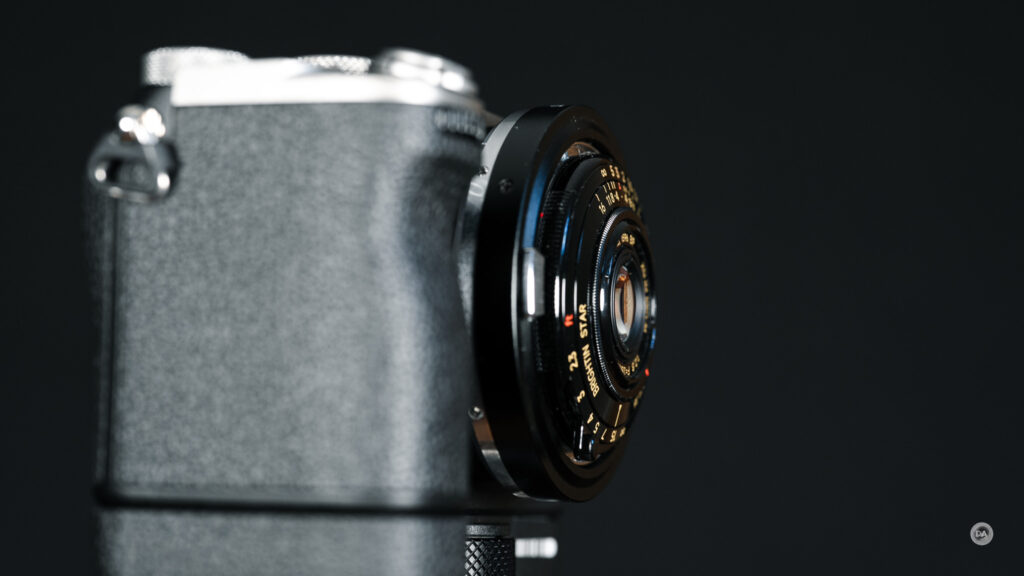
Without the adapter the bare lens is so small that it fits in the palm of my hand with room to spare:
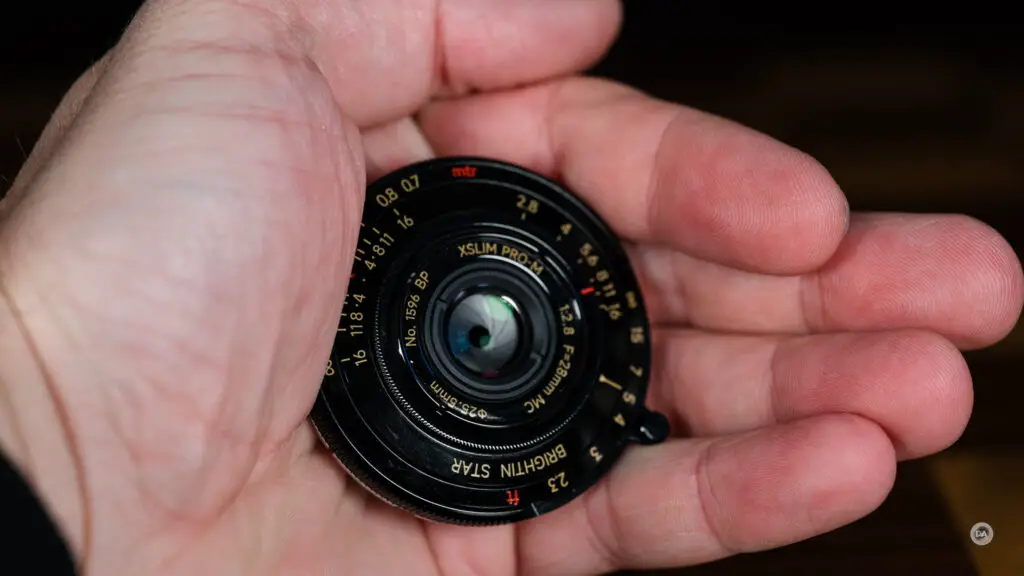
Despite that tiny size the lens can produce legitimately nice images, with nice detail and even fairly decent bokeh:

There are always some compromises when designing a lens this small, however, and we’ll explore both the highs and lows in this review.
Build and Handling
Despite being so tiny, the 28mm Micro is beautifully made. It is made of premium brass and is finished in that rich black lacquer that is different than pretty much any lens I’ve reviewed before. The lens is 51.4mm in diameter and is 21.5mm in overall depth but extends just 9.9mm beyond the camera body/adapter. It weighs in at 125g due to being all metal and glass; still lightweight, but substantial for such a small lens.
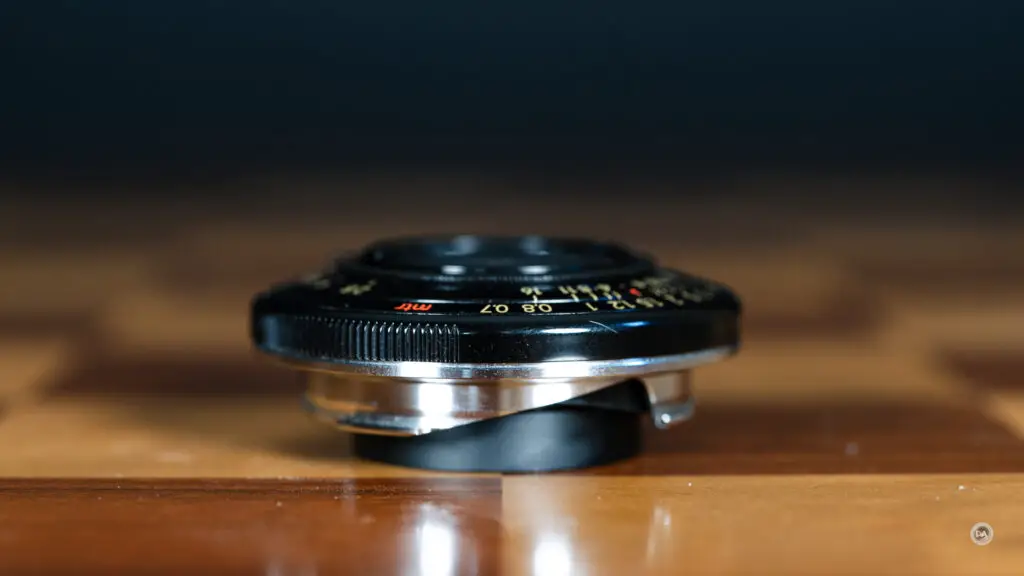
Finding typical filters could be hard, but Brightin Star does include a tiny 25.5mm UV filter that you can use instead of the tiny screw-on metal lens cap that looks like this:

The lens is stamped with all kinds of markings, making it look very retro/steampunk. These are primarily distance scales in both meters and feet along with aperture settings.
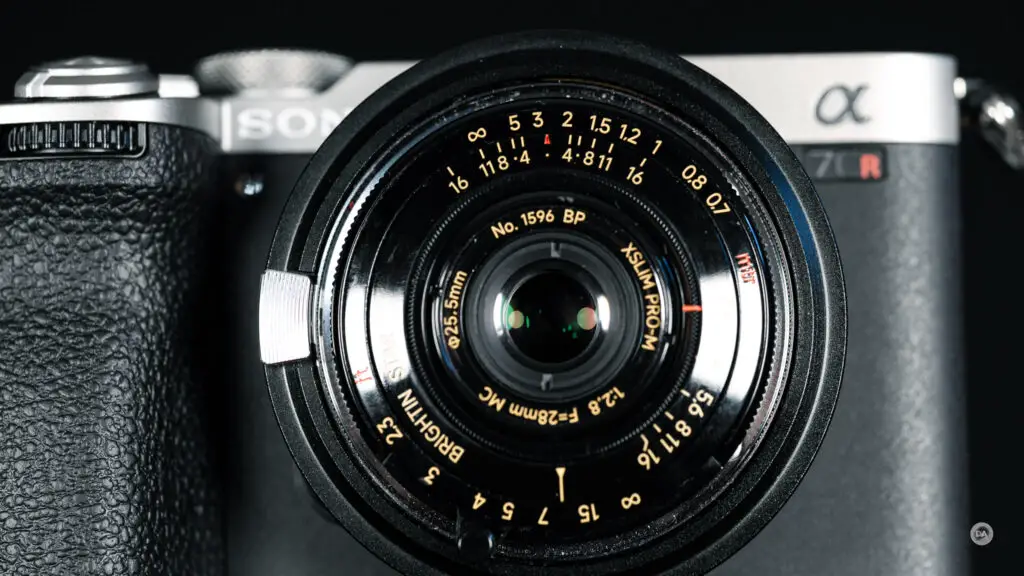
One of my favorite features of the 28mm Micro is the close proximity to the aperture iris, which features 9 rounded blades and makes for a great photography subject itself:

This lens is far too narrow to sport a focus or aperture ring on the side of the barrel (there isn’t really a barrel), so both focus and aperture are controlled from the front of the lens. The easier of the two is focus, as there is a small lever that sticks out and allows one to easily rotate it across the roughly 55° of rotation between minimum and infinity.
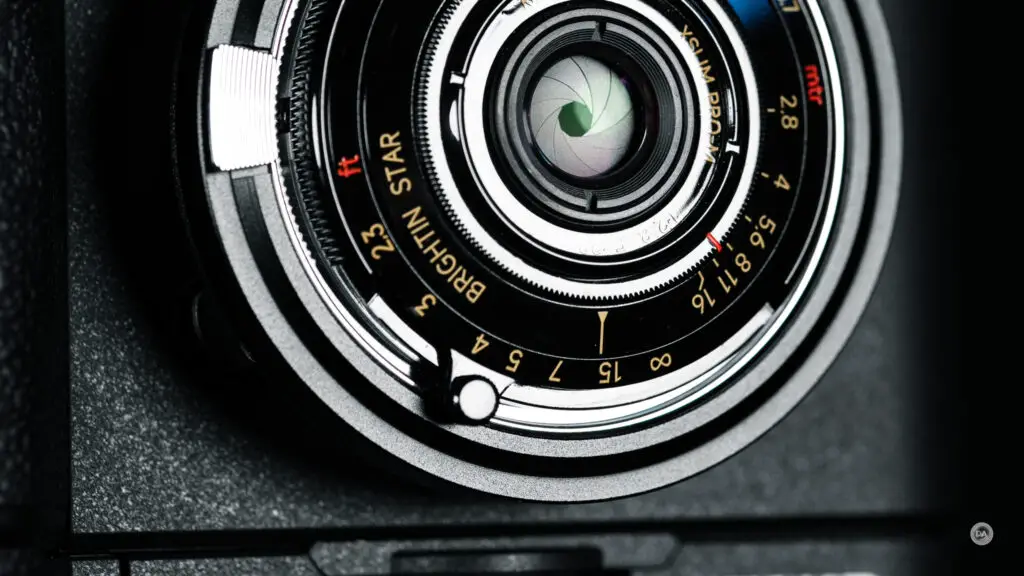
Aperture is much more difficult, as it is controlled by a very narrow ring around the center of the lens that is only raised by 2mm at most. You rotate it more by putting pressure on it and rotating it rather than gripping it. Controlling aperture if it is cold and you are wearing gloves will be basically impossible, and you basically cannot use it without looking at the ring as there is no tactile feedback other than the hard stops at each end.
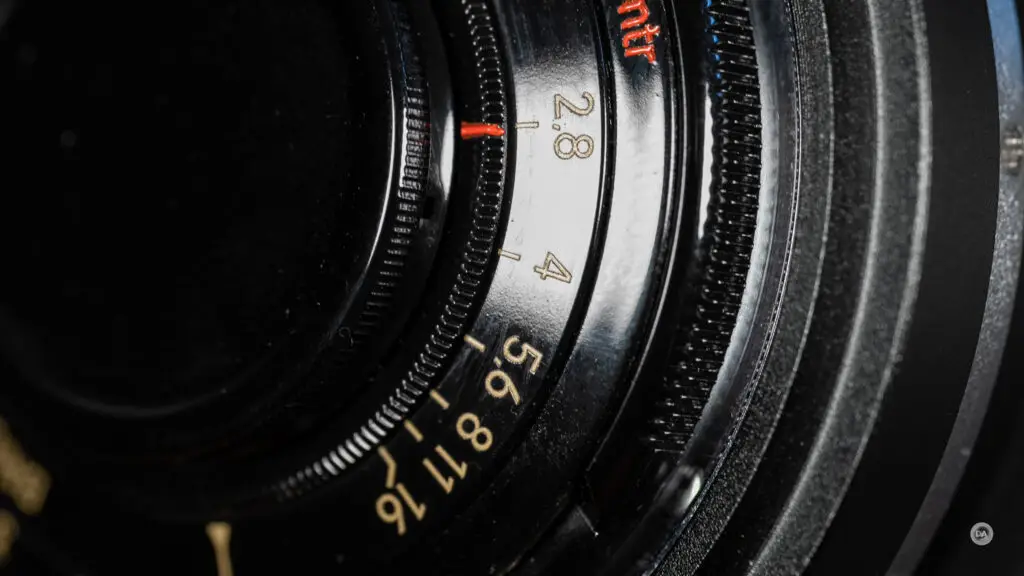
The rear of the lens has a glass element flush with the back of the lens. Everything is metal and glass in this tiny lens.
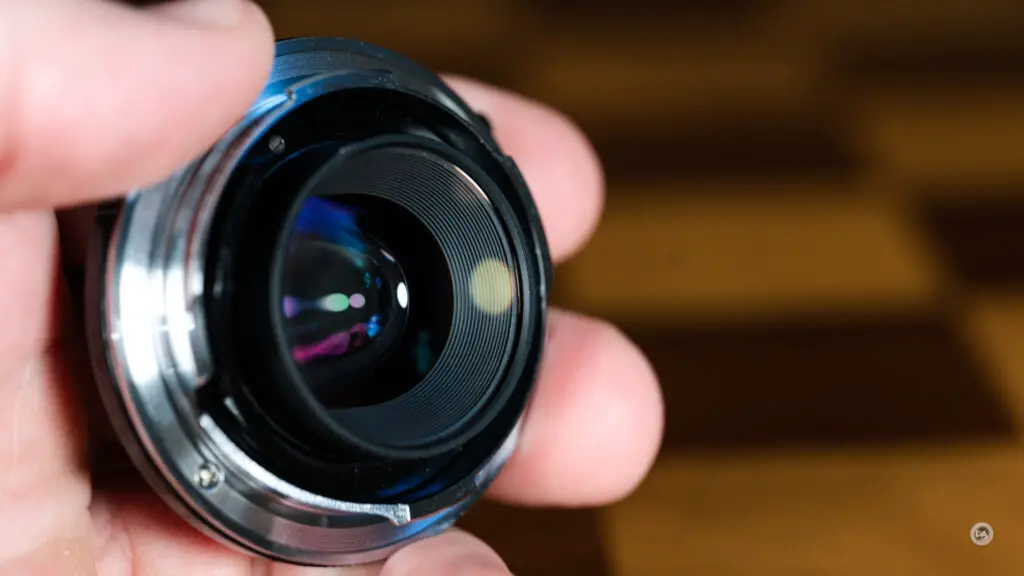
The lens is fully coupled for rangefinder use on Leica cameras, though that doesn’t apply to my use via the Techart adapter.
A few words on that. As per usual, the performance of the Techart adapter varies from lens to lens. It works by moving a lens forwards or backwards (physically) to achieve focus. There doesn’t seem to a significant amount of movement with this tiny Brightin Star 28mm Micro attached, so I found that I had to be a little more particular with where the manual focus ring was positioned to get the best autofocus performance. Somewhere near the 10 foot range seemed to work best for most types of photography, though obviously if I focused the lens closer it would allow me to achieve focus at close distances. The resulting combination of adapter and lens is still extremely compact.
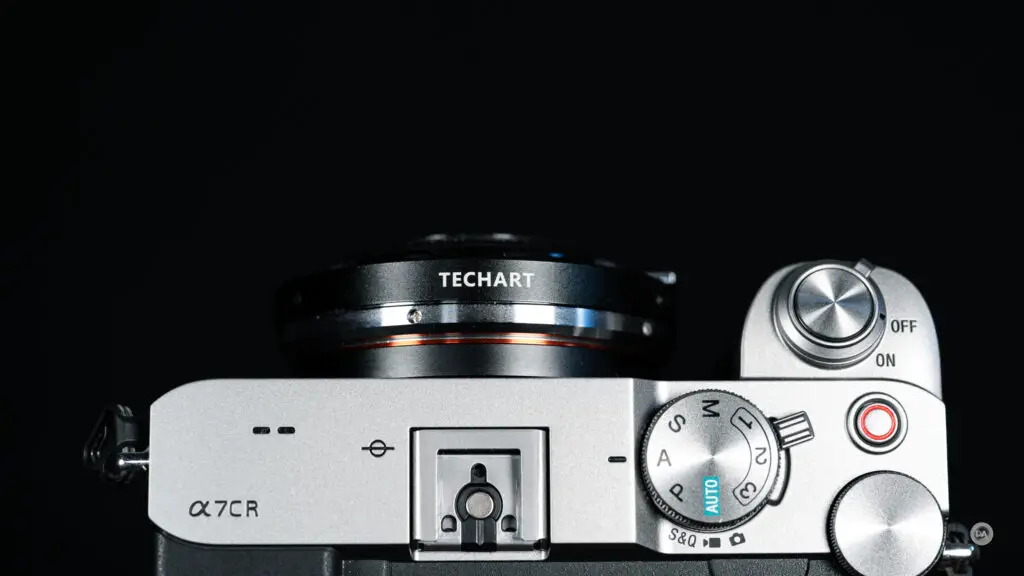
The Brightin Star 28mm F2.8 is certainly one of the most unique lenses that I’ve ever tested, and is definitely a photography objet d’art. There are also some handling compromises involved with producing a pancake lens, and that’s even truer with a lens that makes the typical pancake lens seem bloated and unnecessarily large, but the 28mm Micro does function and can actually be used…and we’ll see how well it can be used in our next section.
Brightin Star 28mm Micro Image Quality
This tiny optic has an optical design of 6 elements in five groups. That last element has to be buried deep in the back of the lens well into the camera (this lens wouldn’t have worked on a camera with a mirror!).

The MTF chart is very interesting, as it shows that the lens is quite sharp in the center and mid-frame (essentially out to the APS-C edge), but then it drops off a cliff and has next to no image quality in the extreme corners. It’s a bit better at F5.6, but not much.
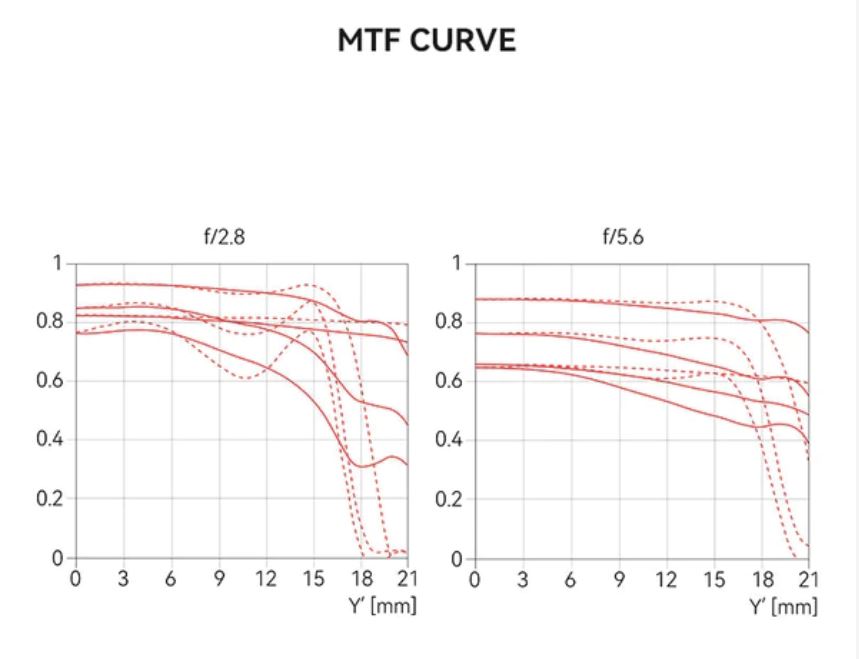
We’ll see in a moment that this isn’t because the lens doesn’t cover the full frame image circle; vignette isn’t unusually bad. But the lens’ design does not adequately cover the full frame image circle optically, leaving some very soft results near the edge of the frame. Whether or not this is a problem will largely depend on what your subject is and what your desire for the shot is. Some vintage lenses had a profile like this, and photographers would use that flaw to focus the eye on the subject (almost like a targeted gaussian blur rather than a vignette).

This is a lens that I suspect would be most valued for street style photography (something that is harder for me to shoot as I live in a more rural area), and that look will often work in that kind of setting. There are some classic photos that come to mind (some of the work of Robert Doisneau, for example) that employ just that kind of style.
We’ll start a detailed examination by taking a look at the vignette and distortion. This is a lens without electronics, and while I can set the focal length in the adapter to report properly (28mm), Lightroom reports this as being the Canon EF 40mm F2.8, for some reason. Just disregard that.
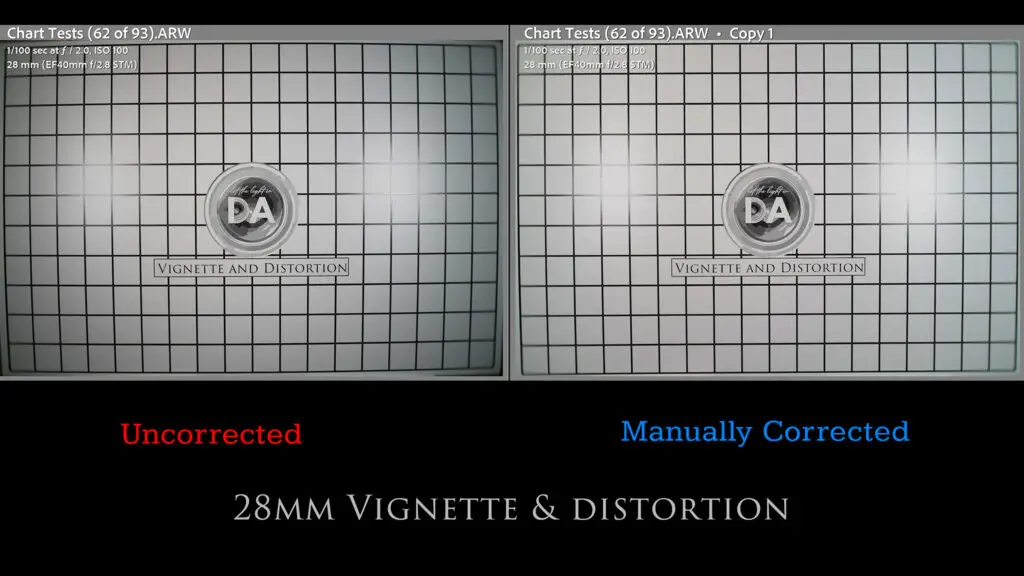
We can see that there is some apparent barrel distortion and fairly heavy vignette. I’ve got a manual correction on the right side, and you can see that I was able to make a fairly clean manual correct of the distortion by using a +8. Vignette is right under 3 stops in the corner and required a +78 to correct. That’s obviously a significant amount of vignette, but far from the worse I’ve seen and not bad for such a tiny lens. There isn’t any of the completely blacked out areas that indicate a lens not covering the full frame image circle – a mechanical vignette. Everything here is just a typical optical vignette, though what is unique is the tremendous amount of blur in the extreme corners.
Longitudinal chromatic aberrations (LoCA) didn’t look too bad, with the main issue being some mild green fringing after the plane of focus.
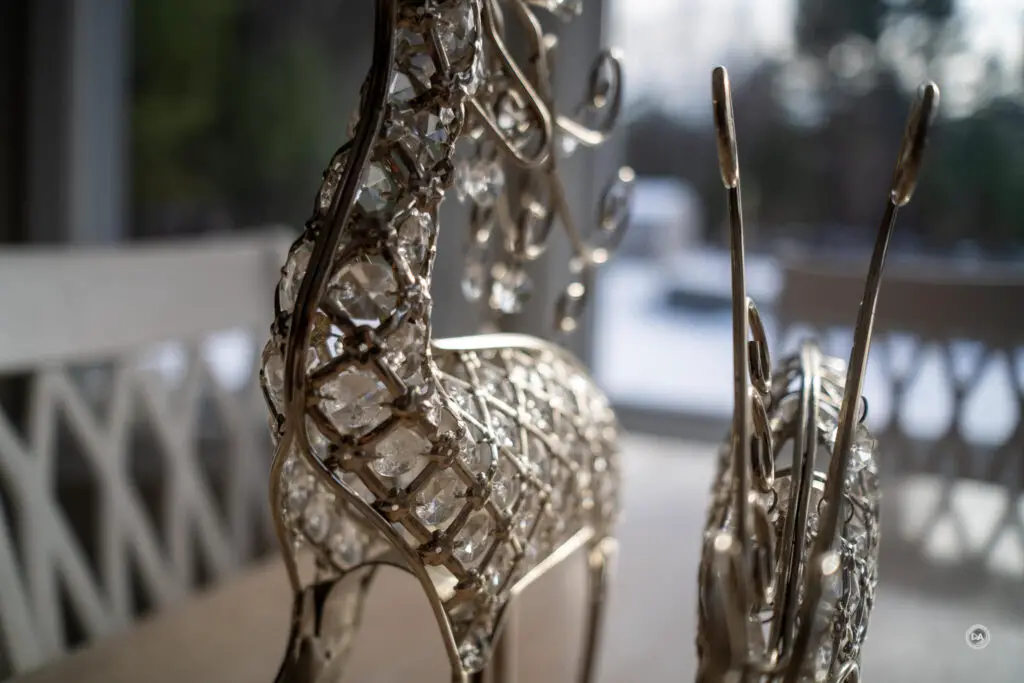

Neither did Lateral CA (LaCA) that shows up near the edges of the frame look bad. There’s clean transitions from black to white near the edges of the frame, though you can see that even at F8 the extreme corners remain very soft.

So how about resolution and contrast. My tests are done on a 61MP Sony a7RV, which is currently the highest resolution point on a full frame camera. Here’s a look at the test chart:

And here are the F2.8 crops at roughly 180% from the center, mid-frame, and lower right corners:
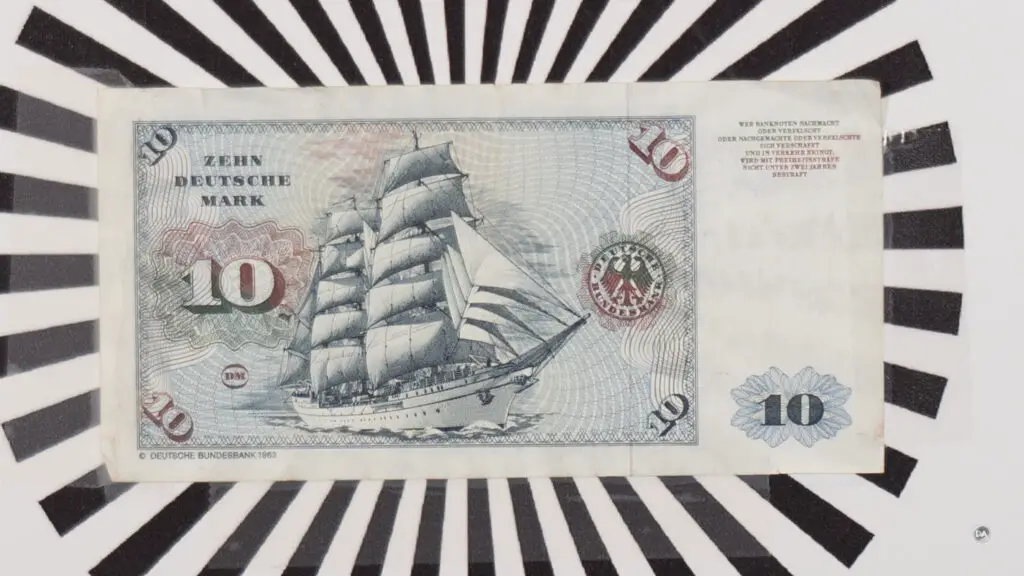

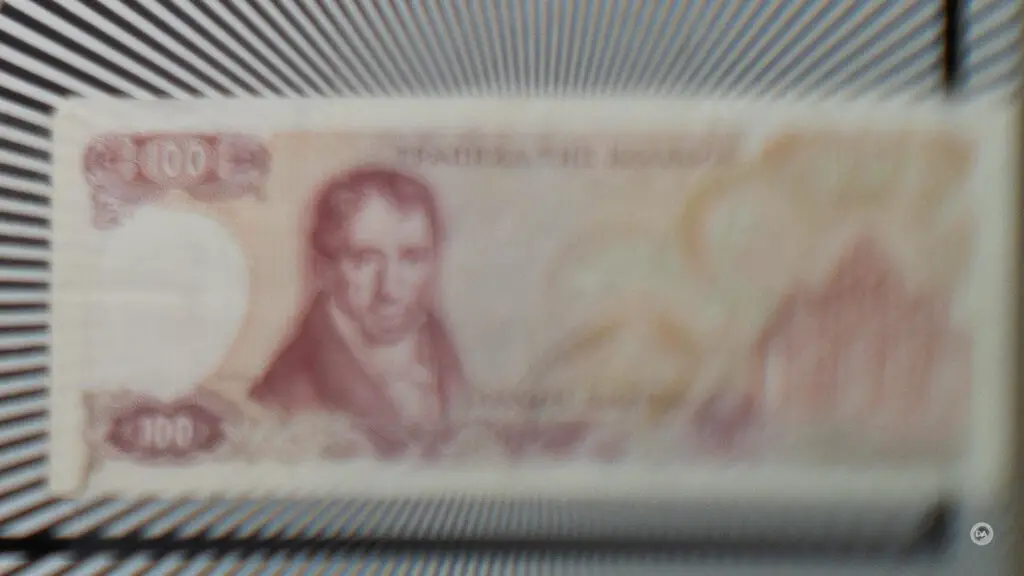
We can see that the center and mid-frame look quite good, but the corners have almost no resolution to speak of. I would have been tempted to attribute some of this to the adapter, but the reality is that Brightin Star’s own MTF charts suggest that this is what one should expect from the lens.
This means that if you are shooting in the sweet spot of the lens, you can expect very nice image results, as you can see here:
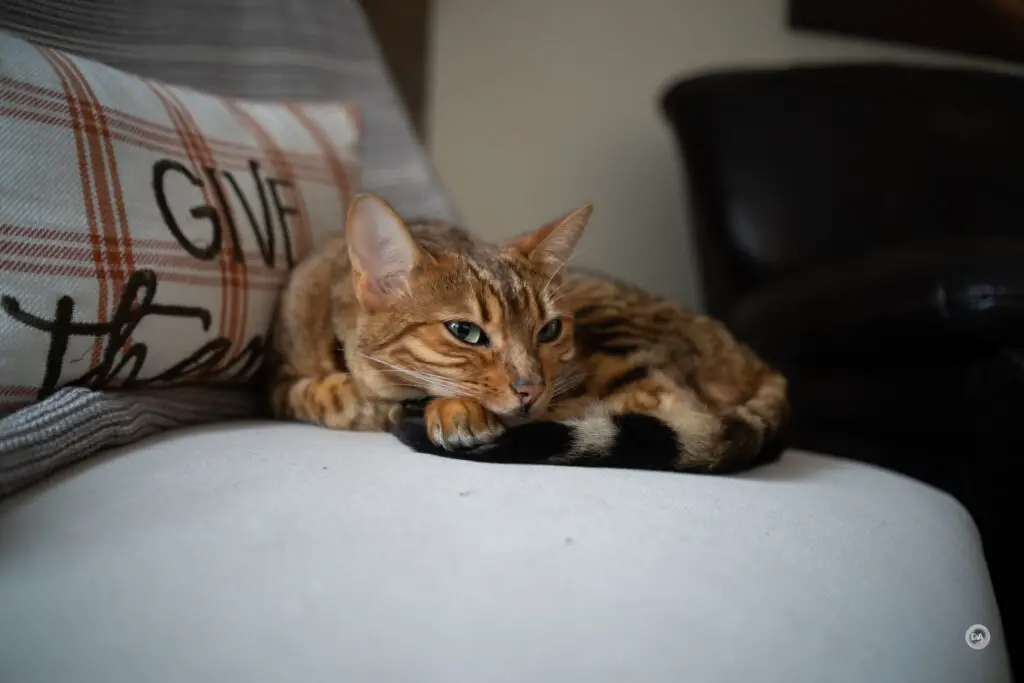
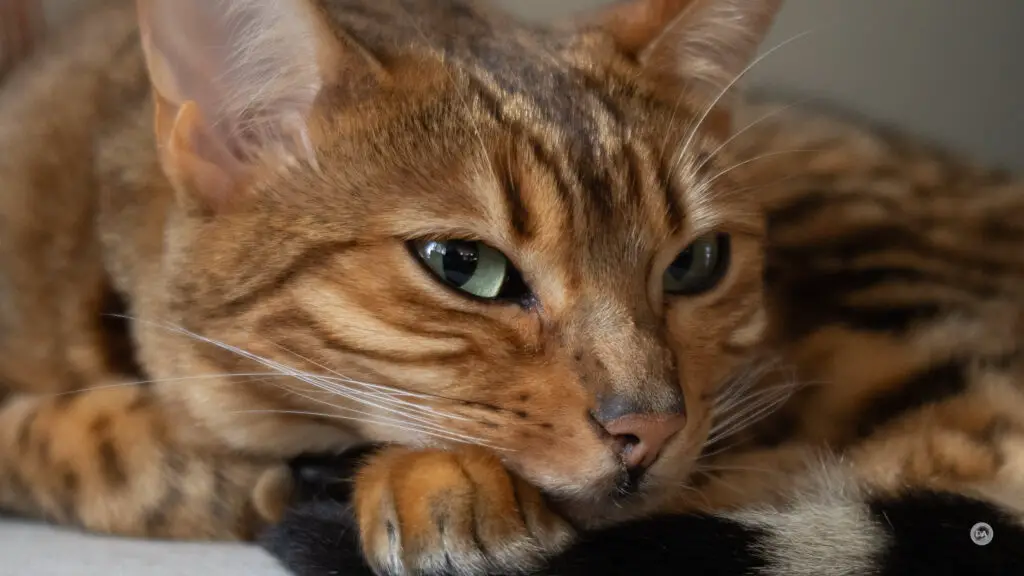
Here’s another shot that shows off a nice blend of sharpness and contrast along with overall rendering.

A close look at the detail shows nice microcontrast on the subject:
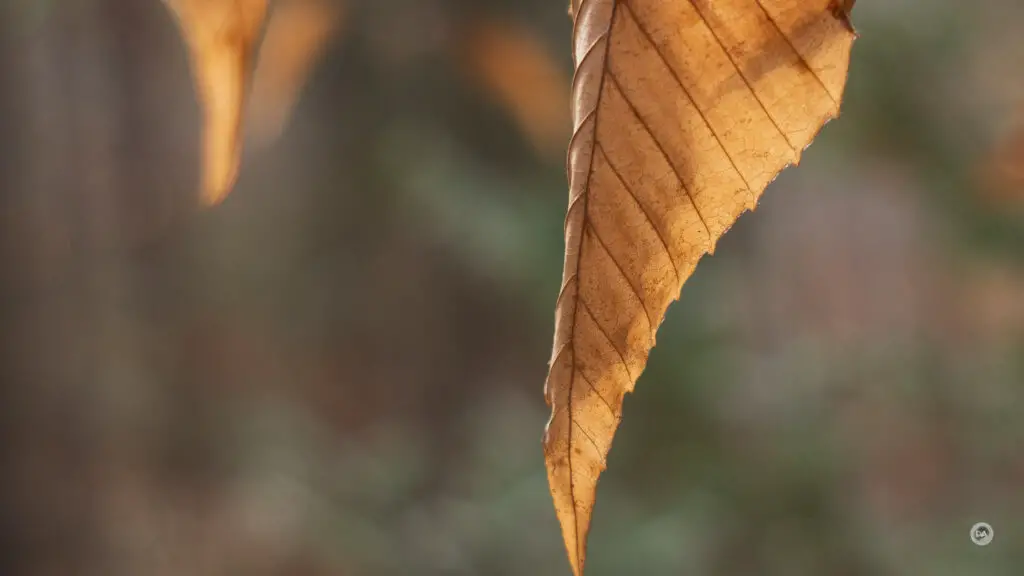
That’s very strong for such a tiny lens. Competing lenses have often had very small maximum apertures (F5.6, for example), and the fact that this tiny 28mm Micro lens is showing such nice image quality at F2.8 is impressive.
Stopping down to F4 shows some improved contrast but not a radical difference in sharpness. Here’s a look at the mid-frame results, with F4 on the right.

There’s a more significant improvement at F5.6, though I see more of an improvement in the mid-frame than in the center. This is a lens that seems to be optimized more for slightly off center compositions; it does well in the “rule of thirds” zones. Look at how much better F5.6 is in the mid-frame than F4:
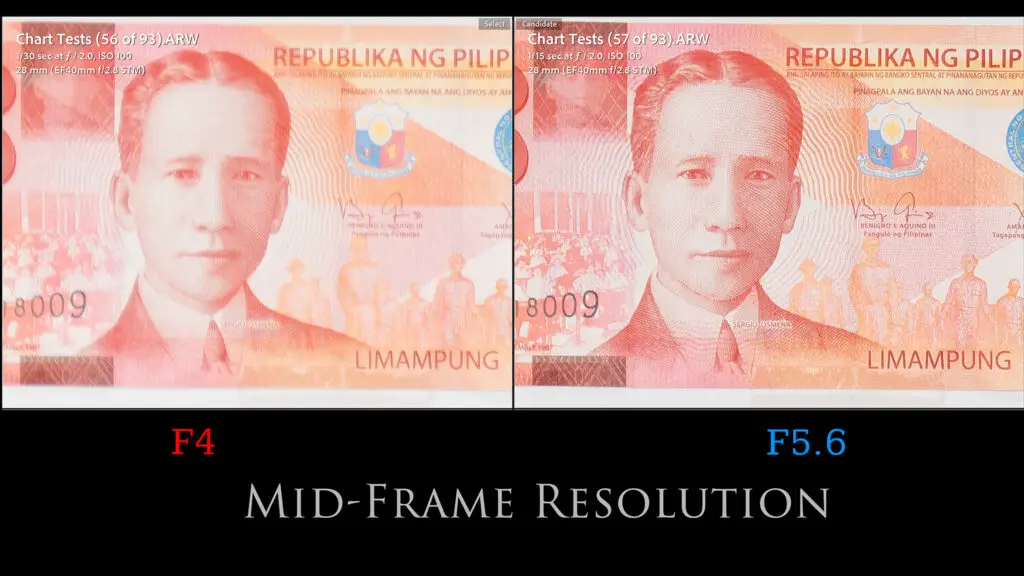
That means that landscape images at F5.6 look really good across most of the frame, but those extreme edges still really fall apart.
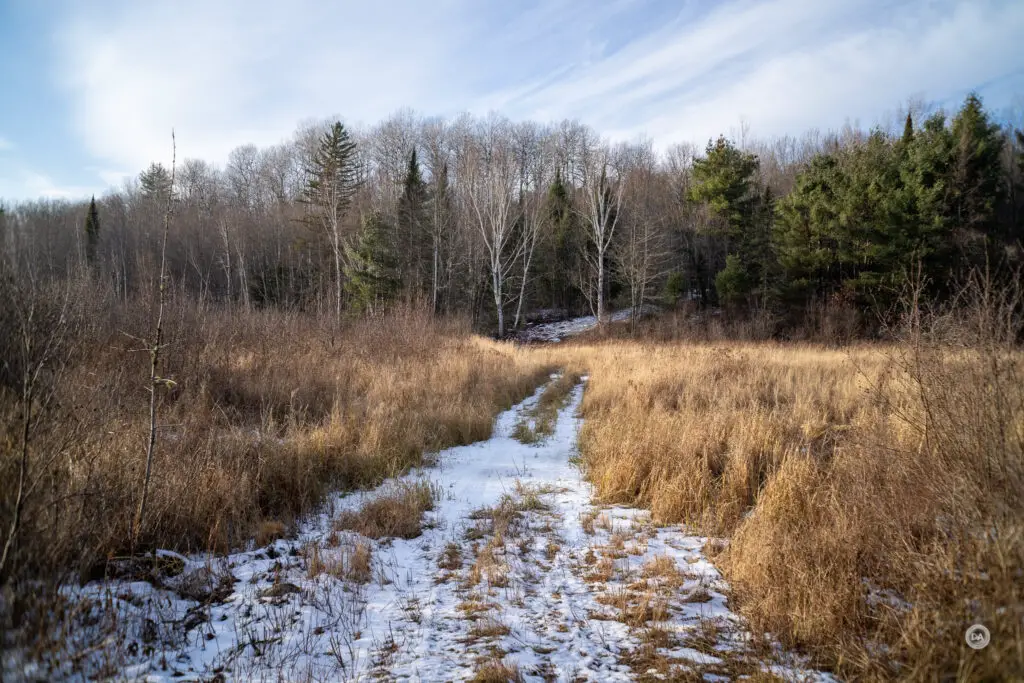


Those corners never really sharpen up. Even at F8 (shown on the left below), you can see that the corners are almost completely unresolved. Diffraction will start to play a part after F8 and the image will start to soften after that, though the exception is the corners, as there’s actually more resolution in the corners at F16 than at any other aperture.

If corner to corner sharpness is your priority, this lens is not for you. If you tend to shoots photos mostly in the rule of thirds zones, then you might really enjoy the images. This shot, for example, doesn’t need a sharp foreground even though the subject covers a lot of the frame.
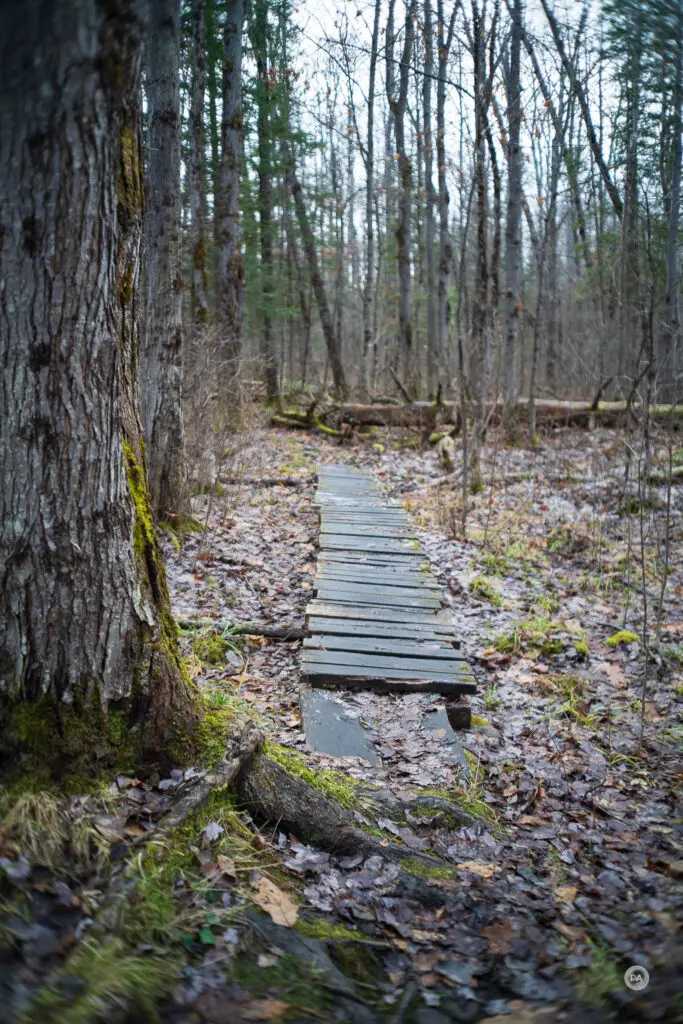
The quality of the bokeh isn’t top tier, but I do think it looks pretty nice.

I’ve got a little bit of advantage by using the adapter, as it allows me to focus a little closer than what the bare lens does (almost like an extension tube). The minimum focus distance is 70cm, which is really long for a 28mm lens, meaning that the normal maximum magnification is REALLY low. I actually wondered if I had shot a minimum focus distance test initially, as this look almost like a normal framing of my test chart.

It’s a shame, as other than a bit of outlining, the quality of the blur is quite good.
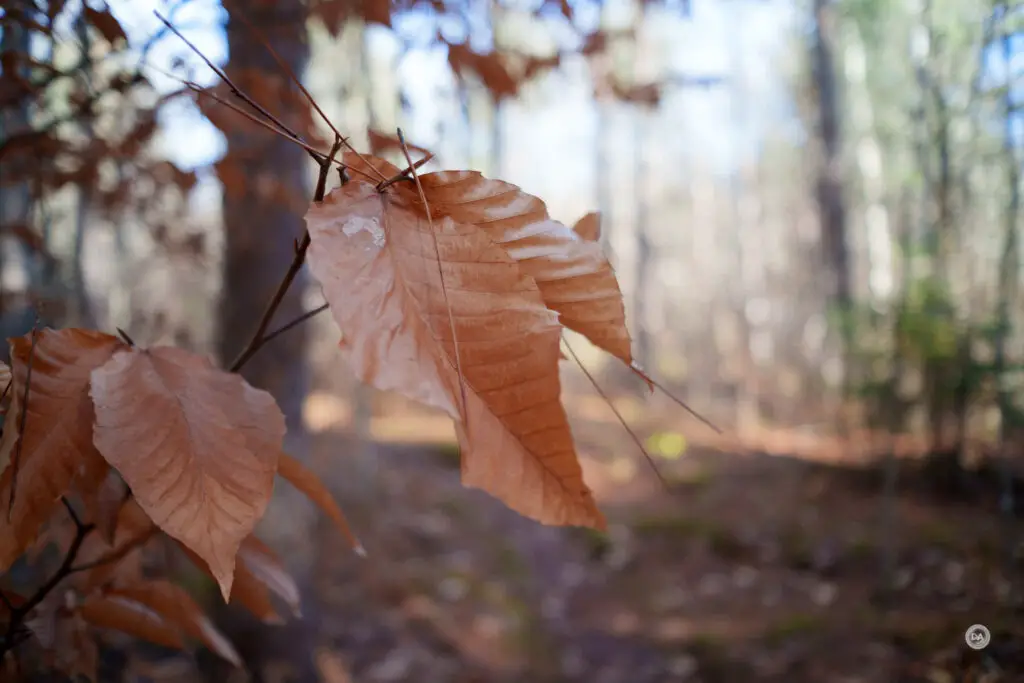
Those shooting on an actual M-mount camera won’t get this advantage, however, due to that very long minimum focus distance.
I found that colors from the lens were slightly undersaturated and could have a slight magenta cast. I could obviously edit that to taste if I wanted, as I did below.
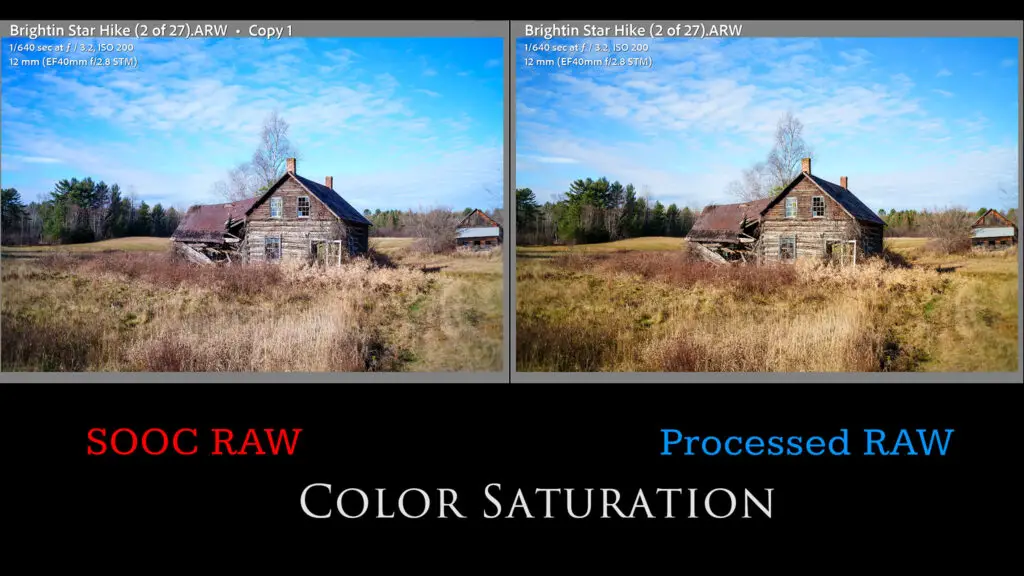
But there were other images where I felt like the color saturation levels really worked for the subject, like here:

Colors are obviously a taste thing, and while I didn’t love all of the images right out of camera, I found that I could get what I wanted out of the RAW images (other than corner sharpness!)
The image above also shows another optic issue – flare. This little lens is extremely flare prone, and is particularly vulnerable to side flare issues (where the sun or light source is out of frame to the side).
This was the worse example of that in my tests:
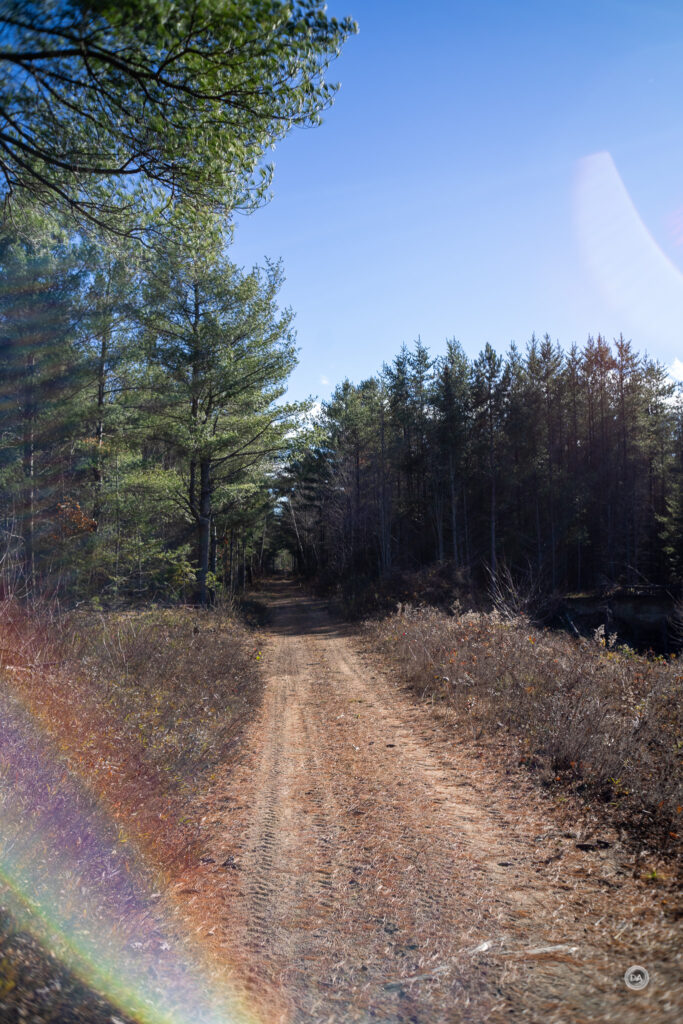
This shot captures some other unique flare issues with some light peaking through the window.
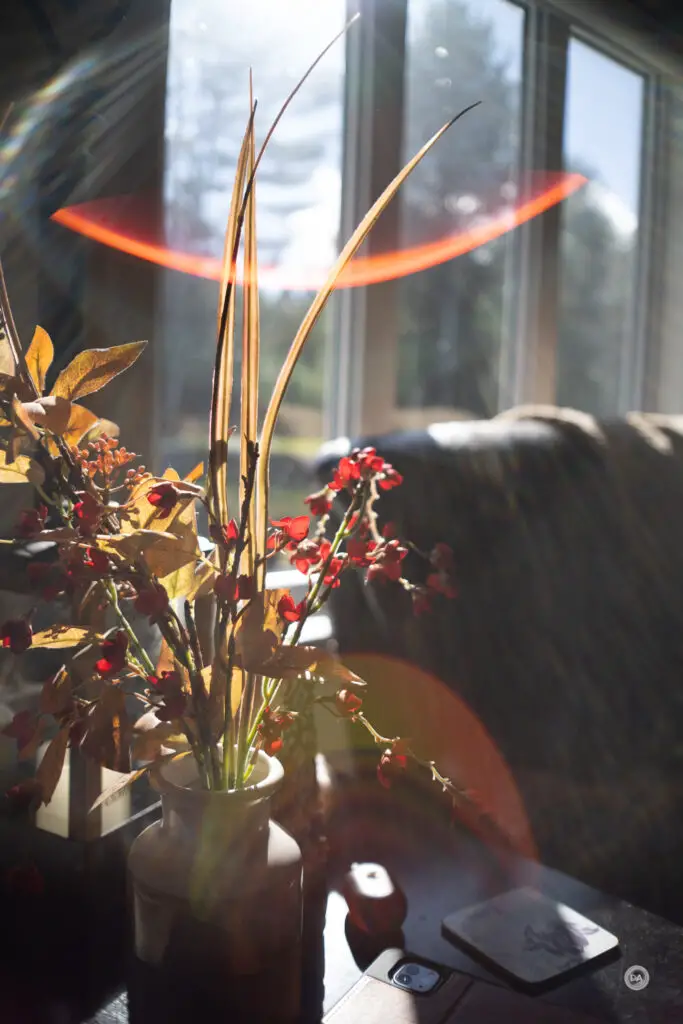
This final trio of images shows the more typical direct sun flare effects at wide open and then stopped down, and the final image shows more faint flare effects on a largely overcast day that made for an interesting effect on the right side of the image.
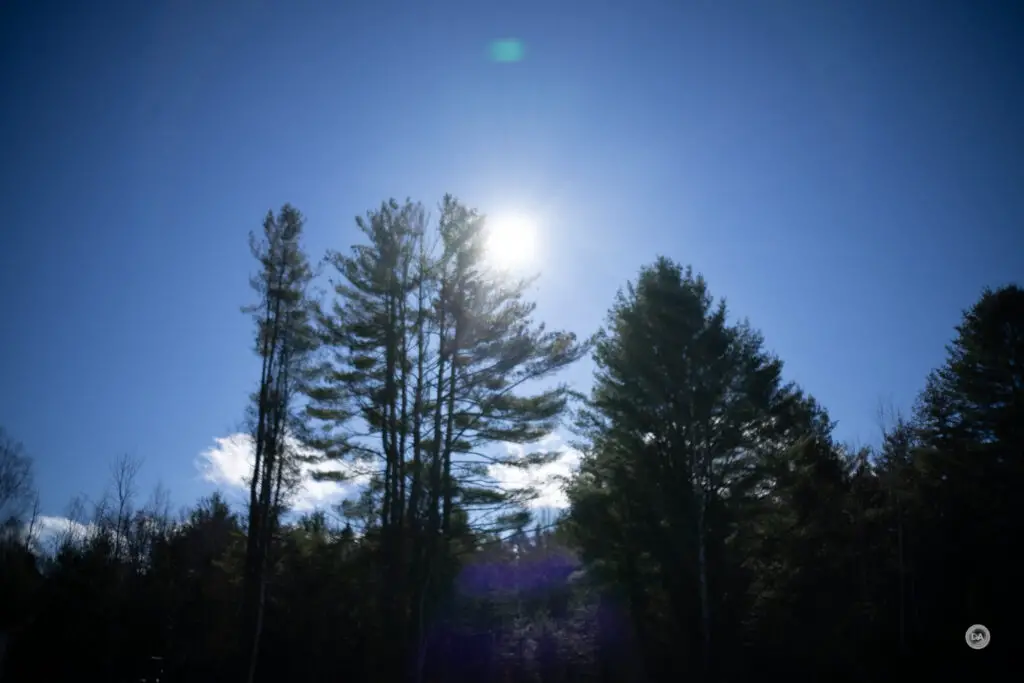
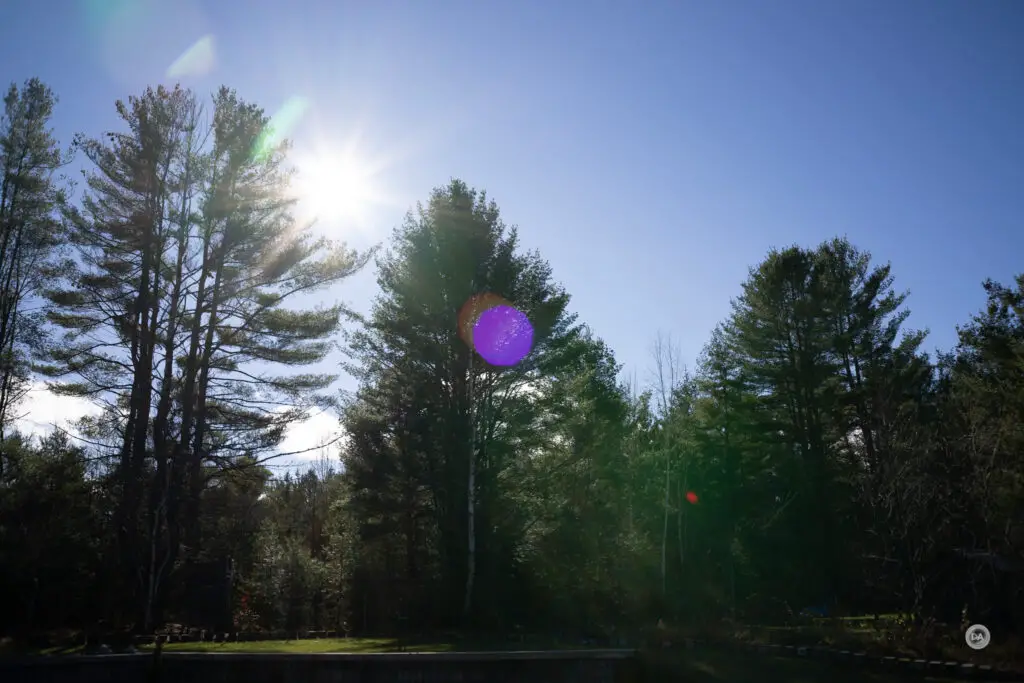

Some of these effects could be used to artful advantage, but you’ll have to approach them carefully as there’s also the potential to ruin an image there.
This is obviously not a conventional modern lens with high levels of corrections for aberrations and lens flaws. There is some vintage rendering there, but I’ve come to realize that there is a market for this kind of lens. Some people love “retro” gear and lenses that have more character than corrections, and few lenses will allow you to travel as discrete and light as this one.
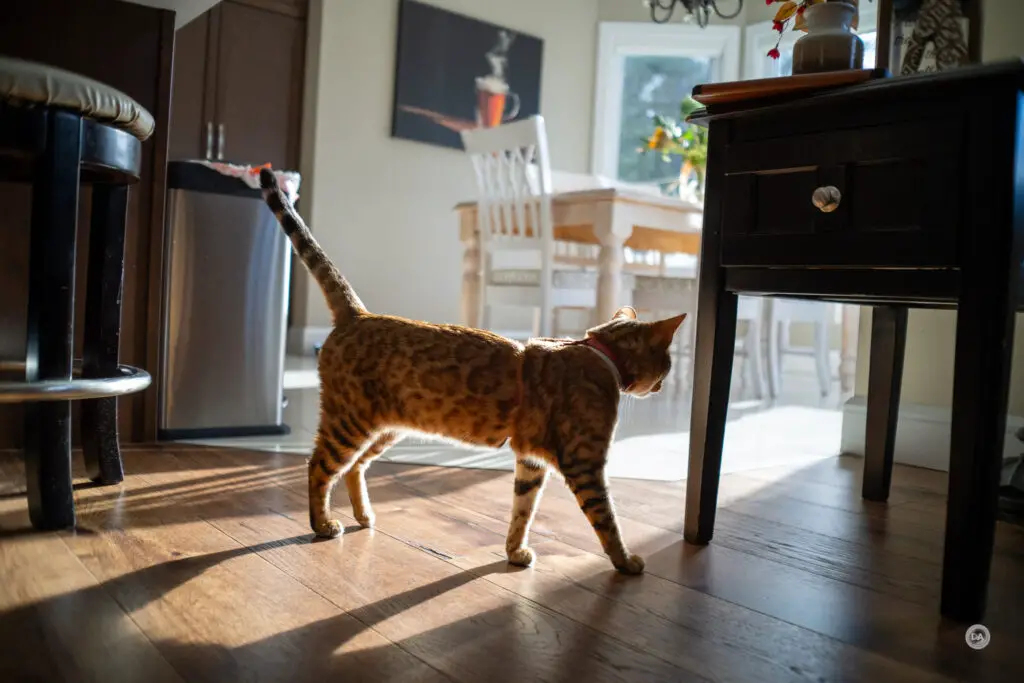
Check out the image gallery for more shots that can help you get a sense of the unique vibe of this tiny lens.
Conclusion
The Brightin Star 28mm F2.8 is further evidence that we are living in a golden age of photography gear. We have so many choices on the market now, and yes, this is a very niche kind of lens, but the fact that companies feel like they can take a chance and produce something like this is fantastic.
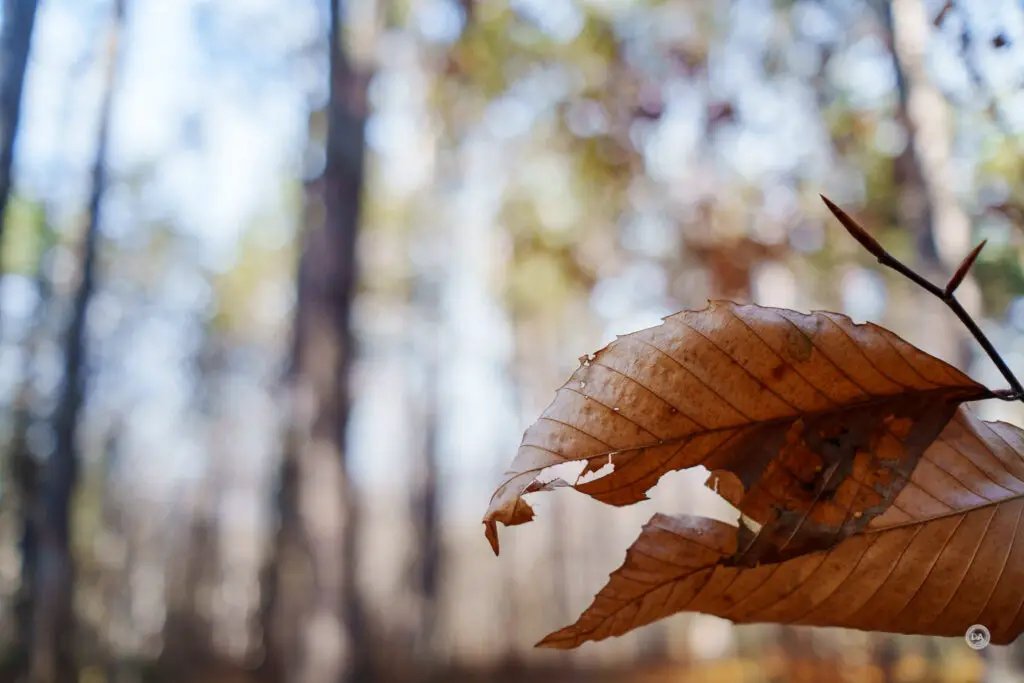
Put this on a compact rangefinder body and you’ve got a lens that scarcely makes a bump at the front of the camera. It’s a novelty that may be as fun to take pictures of as it is to take pictures with, but it’s also a serious lens that can be used to create some beautiful photos.
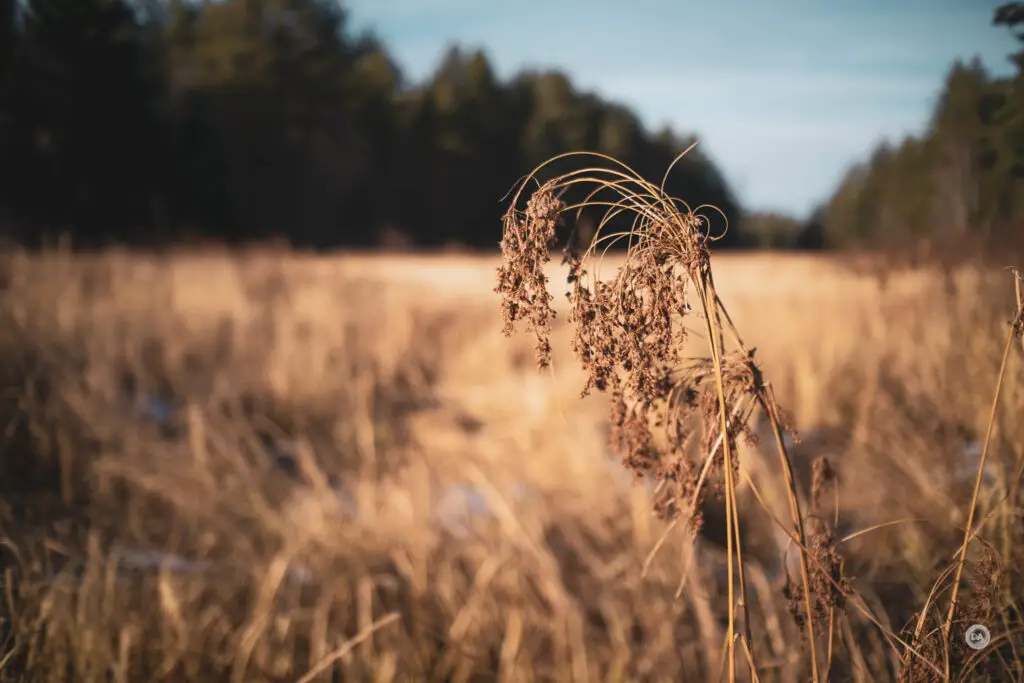
This is not a lens for everyone, obviously, but I suspect that certain photographers will have a blast with the Brightin Star 28mm F2.8…warts and all.
Pros:
- A true little work of art
- Incredibly tiny
- Beautifully made
- Sharp center and mid-frame
- Fairly nice bokeh
- Reasonably controlled distortion and vignette
- Low chromatic aberrations
Cons:
- Almost no corner sharpness…ever
- Very flare prone
- Extremely long minimum focus distance
- Aperture control is ergonomically difficult
_________________________________________________________________________
GEAR USED:
Purchase the Brightin Star 28mm F2.8 @ Amazon or Amazon Canada
Purchase the Sony a7RV @ B&H Photo | Adorama | Amazon | Camera Canada | Sony Canada | Amazon Canada | Amazon UK | Amazon Germany
Purchase the Sony a7IV @ B&H Photo | Adorama | Amazon | Camera Canada | Sony Canada | Amazon Canada | Amazon UK | Amazon Germany
Want to support this channel? Use these affiliate links to shop at: B&H Photo | Amazon | Adorama | Camera Canada | Amazon Canada | Amazon UK | Ebay | Make a donation via Paypal
Buy DA Merchandise https://bit.ly/TWIMerch
Keywords: Brightin Star, 28mm, F2.8, Black Lacquer, M-mount, Rangefinder, Techart, LM-EA9, LMEA9, Techart LM-EA9 Review, LM-EA7, Leica M to E, Full Frame, Review, Sony Alpha 1, Sony a7RV, Review, Hands On, Dustin Abbott, Real World, Comparison, Sharpness, Bokeh, Flare Resistance, Autofocus, Image Quality, Sample Images, Video, Photography, let the light in, #letthelightin, DA
DISCLAIMER: This article and description contains affiliate links, which means that if you click on one of the product links, I’ll receive a small commission. As an Amazon Associate I earn from qualifying purchases.










 Sirui Sniper 75mm F1.2 Review
Sirui Sniper 75mm F1.2 Review  Sirui Sniper 75mm F1.2 Gallery
Sirui Sniper 75mm F1.2 Gallery  Tamron 70-300mm F4.5-6.3 RXD Z-mount Review
Tamron 70-300mm F4.5-6.3 RXD Z-mount Review  Nikkor Z 40mm F2 Review
Nikkor Z 40mm F2 Review 





